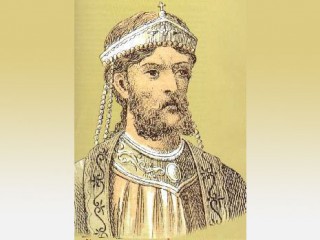
Basil II biography
Date of birth : -
Date of death : -
Birthplace : Byzantine Empire
Nationality : Macedonian
Category : Arhitecture and Engineering
Last modified : 2011-01-13
Credited as : Emperor of Byzantine, ,
The Byzantine emperor Basil II (ca. 958-1025) ruled from 963 to 1025 and was called Bulgaroctonus (Bulgar-Slayer). He was the last and greatest of the emperors who brought Byzantium to its military zenith.
The elder son of Emperor Romanus II, Basil and his younger brother, Constantine, succeeded in title as children upon their father's death in 963. Their position was exploited by two successive military usurpers, Nicephorus Phocas (963-969) and John I Tzimisces (969-976). Upon John's death, while Constantine remained in the background, Basil attempted to rule but became dependent upon his great-uncle, the eunuch Basil the Chamberlain. A cunning politician of long experience, the chamberlain helped Basil face the challenges of two more would-be usurpers, the aristocrats Bardas Sclerus and Bardas Phocas. Amid these struggles the chamberlain's tutelage became intolerable, and Basil drove him from office.
The rebellions of the two Bardases eventually drove Basil to seek military help from Prince Vladimir of Kiev; this alliance led to Russia's subsequent conversion to Byzantine Christianity. The unit of Russian soldiers sent by Vladimir helped Basil stop Bardas Phocas in 989, and Bardas Sclerus capitulated shortly afterward. These long struggles to guarantee his throne left deep scars on Basil's personality. Easygoing and dissipated in his youth, he was turned by his ordeals into a dour, stern, self-denying ascetic. His experiences with ambitious warlords also bred in him a passionate hatred for the aristocrats and a determination to curb them.
With the aristocracy dominating the military high commands, Basil decided early to establish his own reputation as a soldier. An initial attempt at campaigning against Bulgaria, the deadly northern enemy of Byzantium, in 986 had proved an embarrassing failure. In 990, however, Basil resumed his efforts against Bulgaria, which would become the prime target of his mature military efforts. The 25 years of bitter war between King Samuel of Bulgaria and Basil that followed became both a personal duel and a fight to the death between the two enemy states.
With victories, devastation, and bold strategy, Basil wore Samuel down, segmented his territories, and crippled Bulgarian strength. The climax was reached in 1014, when the Byzantines captured the main Bulgarian army of some 14, 000 men. Basil had these men blinded but left one in every hundred with one eye to serve as a guide. He sent them back to Samuel, who died from shock at the sight. Basil completed the annexation of Bulgaria and its incorporation into the empire with singular moderation and pragmatic wisdom.
The next years of the tireless Emperor's reign were spent in settling the empire's interests in eastern Asia Minor and the Caucasus. He began the dismemberment and annexation of independent Armenia. Then, still restless, Basil turned his attentions further westward. He planned an expedition to reconquer Sicily and expand Byzantine authority
in Italy; but before he could undertake this campaign, Basil suddenly took ill and died on Dec. 15, 1025. A bachelor, Basil left the throne to his younger brother, Constantine VIII, during whose reign (1025-1028) began the rapid erosion of the strength Basil had built up.
The chief scholarly study of Basil II is in French. Good general accounts in English are in George Ostrogorsky, History of the Byzantine State (1940; trans. 1956; rev. ed. 1969), and in Romilly Jenkins, Byzantium: The Imperial Centuries, A.D. 610-1071 (1966), part of which is reproduced in J. M. Hussey, ed., The Cambridge Medieval History, vol. 4 (2d ed. 1966), pt. 1.
















